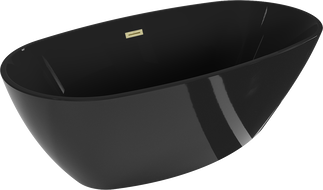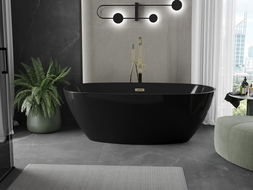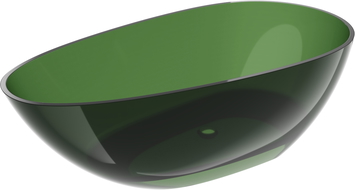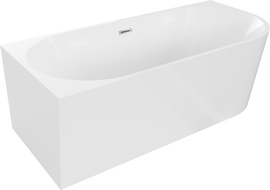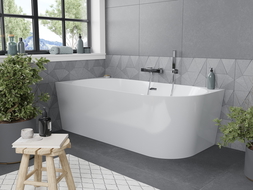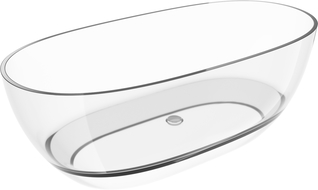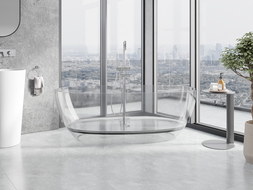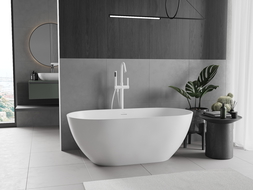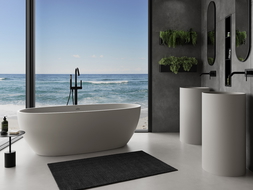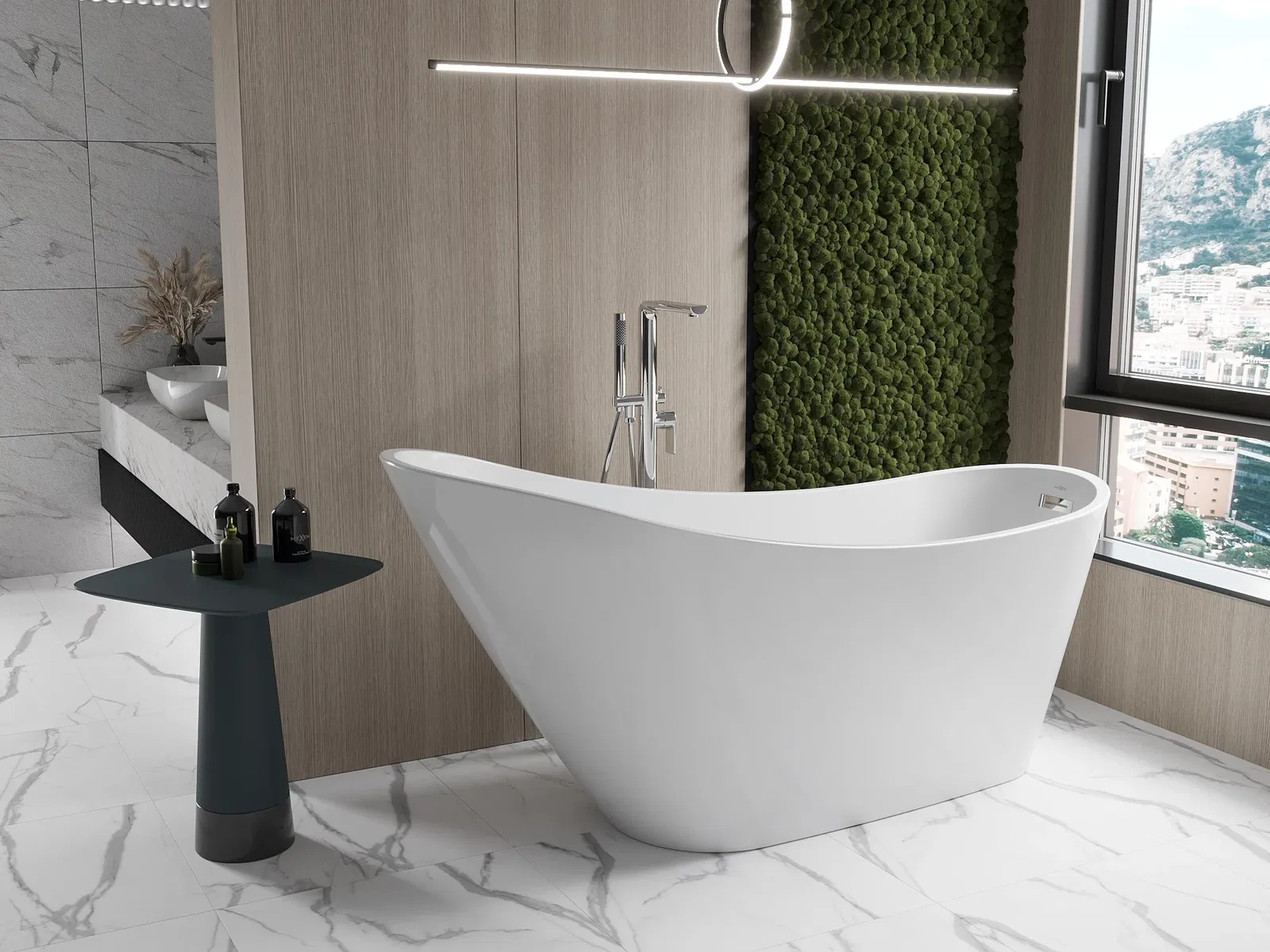
Your dream bathroom is more than just aesthetic tiles and trendy fixtures – it's primarily about a well-chosen bathtub that becomes the heart of the space. It creates a place for relaxation and rejuvenation after a long day. Here, it's worth asking the question: freestanding or built-in bathtub? There are no wrong decisions — it all depends on the available space and design preferences.
What will you learn from this article?
What are the key differences between a freestanding and a built-in bathtub?
Which model is better for a small bathroom and which for a spacious interior?
What are the advantages and disadvantages of different bathtub shapes – from oval to rectangular?
What distinguishes a retro bathtub and which designs does it best suit?
What to consider when choosing a freestanding built-in bathtub?
Freestanding Bathtub – Only for Spacious Bathrooms?
Until recently, the freestanding bathtub was associated with hotel suites, catalog interiors, or luxurious spa areas. Today, it is increasingly found in private bathrooms. Modern technologies and a wide range of models allow you to enjoy this solution even in smaller bathrooms.
A freestanding bathtub is more than just a place for bathing – it's a decorative element of the interior design. It can define the character of a space, giving it distinctiveness and style. It often becomes the focal point of the bathroom, drawing the eye and inviting long moments of relaxation.
Looking for interior inspiration for a small bathroom? Check out our ideas!
What are the Main Benefits of a Freestanding Bathtub?
A freestanding bathtub is synonymous with luxury, enhancing the prestige of any bathroom. Its design is captivating, inviting relaxation and offering great design possibilities. What speaks in favor of this solution?
You can place it anywhere in the bathroom.
Freestanding models come not only in modern versions but also in vintage styles. Bathtubs with decorative feet or matte finishes introduce a retro atmosphere to the interior.
You don't have to worry about bathtub enclosures, which greatly speeds up installation in new bathrooms.
The ergonomic shape of the bathtub and spacious bowl ensure greater bathing comfort.
Freestanding bathtubs are usually made of acrylic, which retains water temperature for a long time, is warm to the touch, and easy to clean. An interesting alternative to acrylic models are exclusive bathtubs made of high-quality composite – a material resistant to mechanical damage, exceptionally durable and aesthetic. Additionally, we offer models made of transparent synthetic resin, giving the bathtub a modern, lightweight appearance and highlighting its unique design.
Would you like to learn more about bathtub enclosure methods? Take advantage of our tips.
Freestanding Bathtub in a Small Bathroom – Is It Possible?
Until recently, it was difficult to find a freestanding bathtub adapted to small interiors. However, manufacturers are responding to users' needs and there is currently a wide selection of bathtubs available for wall placement. Asymmetrical or corner freestanding versions can also help make the most of space.
An important aspect when planning the installation is the plumbing – a freestanding bathtub requires properly routed supply and drain, usually in the floor. In an existing bathroom, this may mean a renovation is needed, so the decision should be made at the design stage.
Built-In Freestanding Bathtub: What Shape to Choose?
Once you've determined the dimensions of the built-in bathtub, it's time to address the most important issue, which is the shape. A wall-mounted built-in bathtub usually has a rectangular shape, although that's not a rule – quite often, asymmetrical bathtubs, e.g., pentagonal ones, are also found. If you'd like the bathtub to become the central point of the room, consider an oval or round model.
Oval Freestanding Bathtub – Pros and Cons
Gentle, rounded lines of a freestanding bathtub add elegance to the bathroom and comfort during baths. Positioned against large windows or as the centerpiece of a bathroom, they are reminiscent of hotel interiors. Of course, you must remember that such bathtubs require sufficient space, and their installation can be more demanding compared to wall-mounted models.
Rectangular Freestanding Bathtub Against the Wall – Customer Reviews
The lines of such a bathtub are very distinctive and perfectly underline the minimalism of the interior. The simple shape facilitates integration with various bathroom fixtures. A major advantage is the possibility of placing such a bathtub against a wall or in the center of the room.
Users praise them for their simple installation (a bathtub enclosed against the wall doesn't require complicated drain installation). Rectangular freestanding bathtubs are often perceived as a compromise between classic built-in bathtubs and more extravagant central models.
Retro Bath: What Does It Mean?
Bathtubs with legs, known as retro baths, are a nod to classic design. They can be made of enamel or cast iron, with their hallmark being ornate legs styled in vintage fashion. They take shapes of lion's paws, shells, or other decorative forms. Retro bathtubs fit excellently in interiors inspired by classic, Provencal, or glamour styles, as well as in eclectic arrangements where various styles blend into a cohesive whole.
What About the Built-In Bathtub?
A built-in bathtub is a tried-and-tested solution, particularly recommended for limited spaces. With the option of custom-made enclosures, you can gain extra storage space, e.g., in the form of niches, shelves, or compartments for cosmetics. The built-in bathtub is usually mounted in a corner or recess, which promotes effective space management and visual order in the bathroom.
The advantage of a built-in bathtub is also the reduced risk of floor splash and easier concealment of installations. Combined with a bath screen, it can also function as a shower. In small bathrooms used by several people, creating a 2-in-1 zone can significantly reduce water consumption costs.
Types of Built-In Bathtubs: Which to Choose for Your Bathroom?
A classic solution for a small bathroom is a built-in bathtub in a rectangular shape. Its ergonomic shape simplifies installation, and the universal design works well in both classic and modern interiors.
The built-in bathtub in a modern version offers much more than it might seem:
Backrest profiling – Walls can be vertical or slightly angled to provide better support for the spine.
Shape of the bottom – The bottom can be flat but is also sometimes subtly contoured, e.g., with a gentle slope toward the drain to facilitate water drainage.
Armrests and seats – Some rectangular built-in bathtubs have integrated armrests or even small, contoured seats.
Depth and rims – Bathtubs can have varying depths and rim widths. Thinner rims give the impression of a more spacious interior, while wider ones serve as additional space for personal care items.
Besides classic rectangular models, our offer includes asymmetrical built-in bathtubs that can be tailored to an interior with an irregular layout. If you'd like to learn more about installation and bathtub accessories, be sure to check out our article.
Disadvantages of Freestanding and Built-In Bathtubs – What to Know Before Buying!
For freestanding bathtubs, the main limitation is space. But there are more challenges:
The installation of a freestanding bathtub requires a refined water installation project, and often strengthening the floor (especially when it's a bathtub on legs).
It may not offer space for cosmetics, so additional shelves or tables are necessary.
When installed in the center of the bathroom, an appropriately matched freestanding faucet is required, which increases costs.
And what are the main disadvantages of a built-in bathtub?
It doesn't allow for as much design freedom.
In classic interiors, it may not stylistically match the rest of the bathroom.
It is less often a decorative element of the bathroom.
It is harder to move or replace – especially if it is tiled.
Built-In or Freestanding Bathtub? Or Perhaps a Compromise?
You don't always have to choose between extremes. There are solutions that combine the advantages of a built-in bathtub with the visual lightness of freestanding models – one of them is freestanding corner bathtubs. This practical compromise ensures a harmonious appearance of the room.
Thanks to its shape, a corner bathtub allows optimal use of the bathroom layout. Available are both symmetrical and asymmetrical models — subtly built-in or exposed in a more decorative way, suitable for modern or more classic interior designs.
Bath comfort or ease of cleaning is basic, but the type of bathtub also matters significantly. Consider whether you want the bathroom to be a minimalist sanctuary, an elegant spa room, or perhaps a compact, family space. It's easier to decide then whether a freestanding or built-in bathtub will work better, or perhaps a corner one that combines the advantages of different types.



















